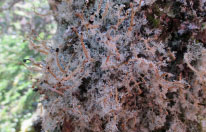Rethinking old-growth forests using lichens as an indicator of conservation value
By Canadian Museum of Nature
3/5/2019
 Ottawa, Mar. 5, 2019 – Two Canadian biologists, including Dr. Troy McMullin of the Canadian Museum of Nature, are proposing a better way to assess the conservation value of old-growth forests in North America—using lichens, sensitive bioindicators of environmental change.
Ottawa, Mar. 5, 2019 – Two Canadian biologists, including Dr. Troy McMullin of the Canadian Museum of Nature, are proposing a better way to assess the conservation value of old-growth forests in North America—using lichens, sensitive bioindicators of environmental change.
McMullin and Dr. Yolanda Wiersma, landscape ecologist at Memorial University of Newfoundland, propose their lichen-focussed system in a paper published online today in the Ecological Society of America journal, Frontiers in Ecology and the Environment.
“We are presenting a paradigm shift for the way we assess forests and manage them,” says McMullin, a lichenologist and research scientist at the museum. “How do we select the forests with highest conservation value? How do we decide what to protect and what to cut? Lichens are part of the answer.”
Old-growth forests, especially those in North America, are perceived to be rich in biodiversity, in addition to capturing aesthetic and spiritual values. These forests are usually defined by the age of the trees, with conservation and management practices developed accordingly. McMullin and Wiersma say this is an over-simplification, as it overlooks the importance of biodiversity in those habitats.
Read more here: http://www.nature.ca/en/about-us/museum-news/news/press-releases/rethinking-old-growth-forests-using-lichens-indicator-conse